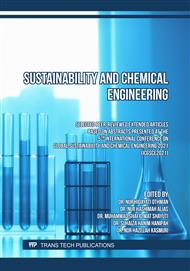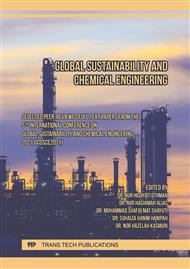[1]
T. Perween, K. Mandal, M. Hasan, Dragon fruit: An exotic super future fruit of India, Journal of Pharmacognosy and Phytochemistry. 7(2) (2018) 1022–1026.
Google Scholar
[2]
S. Glangkarn, Antioxidant Activity in Red Dragon Fruit Jelly, Food and Public Health. 5(5) (2015) 203–206.
Google Scholar
[3]
G. Miliauskas, P.R. Venskutonis, T.A. Van Beek, Screening of radical scavenging activity of some medicinal and aromatic plant extracts, Food Chemistry. 85(2) (2004) 231–237.
DOI: 10.1016/j.foodchem.2003.05.007
Google Scholar
[4]
J. Pérez-Jiménez, S. Arranz, M. Tabernero, M.E. Díaz- Rubio, J. Serrano, I. Goñi, F. Saura- Calixto, Updated methodology to determine antioxidant capacity in plant foods, oils and beverages: Extraction, measurement and expression of results, Food Research International. 41(3) (2008) 274–285.
DOI: 10.1016/j.foodres.2007.12.004
Google Scholar
[5]
A. King, G. Younge, Characteristics and Occurrence of Phenolic Phytochemicals, Journal of the American Dietetic Association. 99 (1999) 213–218.
DOI: 10.1016/s0002-8223(99)00051-6
Google Scholar
[6]
N. Ruzlan, K.R. Kamarudin, S.O. Idid, S.Z. Idid, R.A. Mohamed, M.S. Koya, Antioxidant study of pulp and peel of dragon fruits: A comparative study, International Food Research Journal. 17(1) (2010) 367–375.
Google Scholar
[7]
S.W. Choo, K.W. Yong, Antioxidant properties of two species of Hylocereus fruits, Advances in Applied Science Research. 2(3) (2011) 418– 425.
Google Scholar
[8]
E. Susanti, U.S. Budi, Y. Syukri, T. Redjeki, Phytochemical Screening and Analysis Polyphenolic Antioxidant Activity of Methanolic Extract of white dragon fruit (hylocereus undatus), Indonesian Journal of Pharmacy. 23(1) (2012) 60-64.
Google Scholar
[9]
F.R. Mello, C. De Bernardo, C.O. Dias, L. Gonzaga, E.R. Amante, R. Fett, L.M.B. Candico, Antioxidant Properties, Quantification and Stability of Betalains from Pitaya (Hylocereus undatus) Peel, Food Technology. 45(2) (2015) 323–328.
DOI: 10.1590/0103-8478cr20140548
Google Scholar
[10]
L.K. Cheah, A.M. Eid, A. Aziz, F.D. Ariffin, A. Elmahjoubi, N.A. Elmarzugi, Phytochemical properties and health benefits of hylocereus undatus. Nanomedicine & Nanotechnology Open Access, 1(1) (2016) 1-10.
Google Scholar
[11]
J.G. Ramero, K.G.D. Waing, M.J.G. Valentino, Phytochemical screening and bioassay of the antibacterial activity of hylocereus undatus and hylocereus polyrhizus fruit peel, International Journal of Biology, Pharmacy and Allied Sciences. 6(6) (2017) 1169-1180.
Google Scholar
[12]
A.M. Som, N. Ahmat, H.A.A. Hamid, N.M. Azizuddin, A comparative study on foliage and peels of Hylocereus undatus (white dragon fruit) regarding their antioxidant activity and phenolic content, Heliyon. 5(2) (2019) e01244.
DOI: 10.1016/j.heliyon.2019.e01244
Google Scholar
[13]
A.M. Som, J. Idris, K.H.K. Hamid, Dragon fruit foliage as a low cost plant-based coagulant in latex concentrate wastewater treatment, Malaysian Journal of Chemical Engineering. 1 (2007) 49–59.
Google Scholar
[14]
J. Idris, A.M. Som, M. Musa, K.H.K. Hamid, R. Husen, M.N.M. Rodhi, Dragon fruit foliage plant-based coagulant for treatment of concentrated latex effluent: Comparison of treatment with ferric sulfate, Journal of Chemistry. ( 2013) 1-7. https://doi.org/10.1155/2013/230860.
DOI: 10.1155/2013/230860
Google Scholar
[15]
A.M. Som, A.F.A. Wahab, Performance study of dragon fruit foliage as a plant-based coagulant for treatment of palm oil mill effluent from three-phase decanter, BioResources. 13(2) (2018) 4290-4300.
DOI: 10.15376/biores.13.2.4290-4300
Google Scholar
[16]
N. Turkmen, F. Sari, Y.S. Velioglu, Effects of extraction solvents on concentration and antioxidant activity of black and black mate tea polyphenols determined by ferrous tartrate and Folin-Ciocalteu methods, Food Chemistry. 99(4) (2006) 835–841.
DOI: 10.1016/j.foodchem.2005.08.034
Google Scholar
[17]
Z.Z. Abidin, H. Zahra, M.A. Shavandi, M.H. Shah Ismail, F.R. Ahmadun, Methylene Blue Removal from Aqueous Solution by Hylocereus undatus (Dragon Fruit) Foliage, Applied Mechanics and Materials. 625 (2014) 864–869.
DOI: 10.4028/www.scientific.net/amm.625.864
Google Scholar
[18]
C.W. Sim, Y.W. Khing, Antioxidant properties of two species of Hylocereus fruits. Pelagia Research Library, 2(3) (2011) 418–425.
Google Scholar
[19]
S.Verma, T. Mohanta, T. Revathy, K. Suthindhiran, M.A. Jayasri, Phytochemical and pharmacological evaluation of selected plants, American Journal of Biochemistry and Biotechnology. 9(3) (2013) 291–299.
DOI: 10.3844/ajbbsp.2013.291.299
Google Scholar
[20]
M. Sekar, N.F. Zulkifli, N.A. Azman, N.A.A. Azhar, A.S.M. Norpi, H.I. Musa, N.S. Sahak, M.S. Abdullah, Comparative antioxidant properties of Methanolic extract of red and white dragon fruits, International Journal of Current Pharmaceutical Research. 8(3) (2016) 56-58.
Google Scholar
[21]
I.F.F. Benzie, J.J. Strain, Ferric reducing/antioxidant power assay: Direct measure of total antioxidant activity of biological fluids and modified version for simultaneous measurement of total antioxidant power and ascorbic acid concentration, Methods in Enzymology. 299(1995) (1998) 15–27.
DOI: 10.1016/s0076-6879(99)99005-5
Google Scholar
[22]
C.S. Ezeonu, C.M. Ejikeme, Qualitative and Quantitative Determination of Phytochemical Contents of Indigenous Nigerian Softwoods, New Journal of Science. 2016 (2016) 1–9.
DOI: 10.1155/2016/5601327
Google Scholar
[23]
L. Santos-Zea, A.M. Rosas-Pérez, A.M. Leal-Díaz, J.A. Gutiérrez-Uribe, Variability in Saponin Content, Cancer Antiproliferative Activity and Physicochemical Properties of Concentrated Agave Sap, Journal of Food Science. 81(8) (2016) H2069–H2075.
DOI: 10.1111/1750-3841.13376
Google Scholar
[24]
K. Sudha, D. Baskaran, Evaluation of Functional Properties of Hylocereus Undatus (White Dragon Fruit), International Journal of Agricultural Science and Research. 7(5) (2017) 451–456.
DOI: 10.24247/ijasroct201753
Google Scholar
[25]
Z.Chen, B Zhong, C.J. Barrow, F.R. Dunshea, H.A.R. Suleria, Identification of Phenolic compounds in Australian grown dragon fruits by LC-ESI-QTOF-MS/MS and determination of their antioxidant potential, Arabian Journal of Chemistry. 14(6) (2021) 10315.
DOI: 10.1016/j.arabjc.2021.103151
Google Scholar
[26]
S.H. Attar, M.A. Gundesli, I. Urun, S. Kafkas, N.E. Kafkas, S. Ercisli, C. Ge, J. Mlcek, A. Adamkova, Nutritional Analysis of red-purple and white-flesh pitaya (Hylocereus) species, Molecules. 27(3) (2022) 808.
DOI: 10.3390/molecules27030808
Google Scholar
[27]
N. Uslu, M.M. Ozcan, The effect of ultrasound-vacuum-assisted extraction on bioactive properties of pitaya (Hylocereus undatus), International Food Science and Technology. 56(12) (2021) 6618-6625.
DOI: 10.1111/ijfs.15364
Google Scholar



